Why Does a High Humidity Level Form in Low-Income Households Despite Low Water Vapor Generation?
Abstract
1. Introduction
2. Literature Review
2.1. Indoor Humidity Levels
2.2. Moisture Generation Rate by Various Activities
| Source of Moisture | Moisture Generation Rate | Reference | Nationality | |
|---|---|---|---|---|
| Cooking | All day | 3000 g/day (gas) 2000 g/day (elec) | bs5250(2011) [17] | UK |
| 600–1500 g/h | Bley (1983) [13,52] | Germany | ||
| 5174 g/day | Yik (2004) [53] | China | ||
| 3 meals | 2160 g/day (gas) 920 g/day (elec) | Hansen(1984) [54] | Canada | |
| 900–3000 g/day | CIBSE (2006) [55] | UK | ||
| 535 g/day (gas) 209 g/day (elec) | Atsushi (2019) [56] | Japan | ||
| 957 g/day | Rousseau(1984) [57] | Canada | ||
| Breakfast | 408 g | Hite and Bray (1949) [48] | America | |
| 450 g (gas) 170 g (elec) | Angell and Olson (1988) [49,50,58,62] | America | ||
| 468 g | Watanabe (1965) [59] | Japan | ||
| 257 g | Yik (2004) [53] | China | ||
| Lunch | 530 g | Hite and Bray (1949) [48] | USA | |
| 570 g (gas) 250 g (elec) | Angell and Olson (1988) [49,50,58,62] | USA | ||
| 159 g | Watanabe (1965) [59] | Japan | ||
| 948 g | Yik (2004) [53] | China | ||
| Dinner | 1220 g | Hite and Bray (1949) [48] | USA | |
| 1330 g (gas) 580 g (elec) | Angell and Olson (1988) [49,50,58,62] | USA | ||
| 3859 g | Yik (2004) [53] | China | ||
| 946 g | Watanabe (1965) [59] | Japan | ||
| Bathing | Shower | 600 g/15 min shower | bs5250 (2011) [17] | UK |
| 230 g/shower | Hansen (1984) [54] | Canada | ||
| 304 g/shower | Rousseau (1984) [57] | Canada | ||
| 113–226 g/shower | Hite and Bray (1949) [48] | USA | ||
| 250 g/5 min shower | Angell and Olson (1988) [49,50,58,62] | USA | ||
| 2600 g/h | Schmittlutz (1975) [13,60] | Germany | ||
| 530 g/18 min shower | Yik (2004) [53] | China | ||
| Tub | 50 g/bath | Hansen (1984) [54] | Canada | |
| 174 g/bath | Rousseau (1984) [57] | Canada | ||
| 700 g/h | Schmittlutz (1975) [13,60] | Germany | ||
| 54 g/bath | Hite and Bray (1949) [48] | USA | ||
| 60 g/bath | Angell and Olson (1988) [49,50,58,62] | USA | ||
| Drying clothes | Unvented dryer | 1500 g/day | bs5250 (2011) [17] | UK |
| 11,970 g/day | Hansen (1984) [54] | Canada | ||
| Indoor drying | 50–200 g/h (spin dried), 100–500 g/h (dripping wet) | Erhorn (1986) [13,61] | Germany | |
| 1,1974 g/day | Hite and Bray (1949) | USA | ||
| 2200–2920 g/load | Angell and Olson (1988) [49,50,58,62] | USA | ||
| 2000–5000 g/day | CIBSE (2006) [55] | UK | ||
| 1740 g/day | Rousseau (1984) [57] | Canada | ||
| 1666 g/day | Yik (2004) [53] | China | ||
| 1100 g/person per day | Atsushi (2019) [56] | Japan | ||
3. Field Measurements
3.1. Long-Term Field Measurements
3.2. Controlled Field Measurements
3.2.1. Bathing and Showering
3.2.2. Cooking
3.2.3. Drying Clothes
3.3. Measurement Results
3.3.1. Assessment of Moisture Excess by Long-Term Measurement
3.3.2. Quantification of Moisture Generation Rates by Various Activities
- Bathing and showering
- Cooking
- Drying clothes
4. Discussion and Conclusions
Author Contributions
Funding
Conflicts of Interest
References
- Bluyssen, P.M. Towards an integrative approach of improving indoor air quality. Build. Environ. 2009, 44, 1980–1989. [Google Scholar] [CrossRef]
- Toftum, J.; Jørgensen, A.S.; Fanger, P. Upper limits for indoor air humidity to avoid uncomfortably humid skin. Energy Build. 1998, 28, 1–13. [Google Scholar] [CrossRef]
- Toftum, J.; Jørgensen, A.S.; Fanger, P. Upper limits of air humidity for preventing warm respiratory discomfort. Energy Build. 1998, 28, 15–23. [Google Scholar] [CrossRef]
- American Society of Heating, Refrigerating and Air-Conditioning Engineers. 2013 ASHRAE Handbook: Fundamentals; American Society of Heating, Refrigerating and Air-Conditioning Engineers Inc.: Peachtree Corners, GA, USA, 2013. [Google Scholar]
- Fang, L.; Clausen, G.; Fanger, P.O. Impact of temperature and humidity on chemical and sensory emissions from building materials. Indoor Air 1999, 9, 193–201. [Google Scholar] [CrossRef]
- Simonson, C.J.; Salonvaara, M.; Ojanen, T. The effect of structures on indoor humidity—Possibility to improve comfort and perceived air quality. Indoor Air 2002, 12, 243–251. [Google Scholar] [CrossRef]
- Kitagawa, K.; Komoda, N.; Hayano, H.; Tanabe, S.-I. Effect of humidity and small air movement on thermal comfort under a radiant cooling ceiling by subjective experiments. Energy Build. 1999, 30, 185–193. [Google Scholar] [CrossRef]
- Choi, J.; Chun, C.; Sun, Y.; Choi, Y.; Kwon, S.; Bornehag, C.-G.; Sundell, J. Associations between building characteristics and children’s allergic symptoms—A cross-sectional study on child’s health and home in Seoul, South Korea. Build. Environ. 2014, 75, 176–181. [Google Scholar] [CrossRef]
- Fisk, W.J.; Mendell, M.J.; Lei-Gomez, Q. Meta-analyses of the associations of respiratory health effects with dampness and mold in homes. Indoor Air 2007, 17, 284–296. [Google Scholar] [CrossRef]
- Kelly, K.M. Indoor moisture: Effects on structure, comfort, energy consumption, and health. In Proceedings of the ASHRAE/DOE Conference Thermal Performance of the Exterior Envelope of Buildings, Las Vegas, NV, USA, 6–9 December 1982; pp. 1007–1032. [Google Scholar]
- Bornehag, C.-G.; Sundell, J.; Bonini, S.; Custovic, A.; Malmberg, P.; Skerfving, S.; Sigsgaard, T.; Verhoeff, A. Dampness in buildings as a risk factor for health effects, EUROEXPO: A multidisciplinary review of the literature (1998–2000) on dampness and mite exposure in buildings and health effects. Indoor Air 2004, 14, 243–257. [Google Scholar] [CrossRef]
- Ma, X.; Li, X.; Shao, X.; Jiang, X. An algorithm to predict the transient moisture distribution for wall condensation under a steady flow field. Build. Environ. 2013, 67, 56–68. [Google Scholar] [CrossRef]
- Hens, H. IEA Annex 14: Condensation and energy. J. Therm. Insul. 1992, 15, 261–273. [Google Scholar] [CrossRef]
- Cho, W.; Iwamoto, S.; Kato, S. Condensation risk due to variations in airtightness and thermal insulation of an office building in warm and wet climate. Energies 2016, 9, 875. [Google Scholar] [CrossRef]
- Leccese, F.; Salvadori, G.; Barlit, M. Ventilated flat roofs: A simplified model to assess their hygrothermal behaviour. J. Build. Eng. 2019, 22, 12–21. [Google Scholar] [CrossRef]
- Ministry of Land, Infrastructure and Transportation. Korean Design Standard for Preventing Condensation in Apartment Buildings; Ministry of Land, Infrastructure and Transportation: Seoul, Korea, 2016. [Google Scholar]
- British Standard Institutions. Code of Practice for Control of Condensation in Buildings; BSI: London, UK, 2011. [Google Scholar]
- Werner, H. Wärmeschutz und Energieeinsparung in Gebäuden, Berechnung des Jahres-Heizwärmeund des Jahresheizenergiebedarfs; DIN: Berlin, Germany, 2019. [Google Scholar]
- Dutch Building Code Online. Available online: https://www.bouwbesluitonline.nl/ (accessed on 12 March 2020).
- ÖNorm, B. 8110-2, 2003: Wärmeschutz im Hochbau-Teil 2: Wasserdampfdiffusion und Kondensationsschutz; Österreichisches Normungsinstitut: Vienna, Austria, 2003. [Google Scholar]
- Evans, M.; Chon, H.; Shui, B.; Lee, S.E. Country Report on Building Energy Codes in Republic of Korea; Pacific Northwest National Laboratory: Richland, WA, USA, 2009. [Google Scholar]
- AAMA. Thermal Transmittance and Condensation Resistance of Windows, Doors and Glazed Wall Sections; AAMA: Chicago, IL, USA.
- Koo, S.Y.; Park, S.; Song, J.-H.; Song, S.-Y. Effect of surface thermal resistance on the simulation accuracy of the condensation risk assessment for a high-performance window. Energies 2018, 11, 382. [Google Scholar] [CrossRef]
- ISO. Hygrothermal Performance of Building Components and Building Elements-Internal Surface Temperature to Avoid Critical Surface Humidity and Interstitial Condensation-Calculation Methods; ISO: Brussels, Belgium, 2012. [Google Scholar]
- Lee, H.-H.; Oh, H.-R.; Lim, J.-H.; Song, S.-Y. Evaluation of the thermal environment for condensation and mold problem diagnosis around built-in furniture in Korean apartment buildings during summer and winter. Energy Procedia 2016, 96, 601–612. [Google Scholar] [CrossRef]
- Galvin, R. The Rebound Effect in Home Heating; Routledge: Abingdon, UK, 2015. [Google Scholar]
- Boardman, B. Fuel Poverty: From Cold Homes to Affordable Warmth; Pinter Pub Limited: London, UK, 1991. [Google Scholar]
- Lee, D.; Lee, K.; Bae, H. Characterization of indoor temperature and humidity in low-income residences over a year in Seoul, Korea. Asian J. Atmos. Environ. 2017, 11, 184–193. [Google Scholar] [CrossRef]
- Bopp, K. Housing Energy and Thermal Comfort: A Review of 10 Countries within the WHO European Region; WHO Regional Office for Europe: Copenhagen, Denmark, 2007. [Google Scholar]
- Park, S.; Kim, J.; Song, D. The effect of an energy refurbishment scheme on adequate warmth in low-income dwellings. Sustainability 2019, 11, 2574. [Google Scholar] [CrossRef]
- Oreszczyn, T.; Hong, S.H.; Ridley, I.; Wilkinson, P.; Warm Front Study Group. Determinants of winter indoor temperatures in low income households in England. Energy Build. 2006, 38, 245–252. [Google Scholar] [CrossRef]
- Statics Korea. Population and Housing Census; Statics Korea: Daejeon, Korea, 2018.
- Kim, J.; Myoung, J.; Lim, H.; Song, D. Efficiency gap caused by the input data in evaluating energy efficiency of low-income households’ energy retrofit program. Sustainability 2020, 12, 2774. [Google Scholar] [CrossRef]
- Burr, M.L.; Leger, A.S.S.; Yarnell, J.W.G. Wheezing, dampness, and coal fires. J. Public Health 1981, 3, 205–209. [Google Scholar] [CrossRef]
- Burr, M.L.; Miskelly, F.G.; Butland, B.K.; Merrett, T.G.; Vaughan-Williams, E. Environmental factors and symptoms in infants at high risk of allergy. J. Epidemiol. Commun. Health 1989, 43, 125–132. [Google Scholar] [CrossRef] [PubMed]
- Burr, M.; Mullins, J.; Merrett, T.; Stott, N. Indoor moulds and asthma. J. R. Soc. Health 1988, 108, 99–101. [Google Scholar] [CrossRef] [PubMed]
- Oreszczyn, T.; Ridley, I.; Hong, S.H.; Wilkinson, P.; Warm Front Study Group. Mould and winter indoor relative humidity in low income households in England. Indoor Built Environ. 2006, 15, 125–135. [Google Scholar] [CrossRef]
- European Cyclists’ Federation. Wood preservatives—Determination of the Protective Effectiveness against Wood Destroying Basidiomycetes—Application by Surface Treatment; BSI: London, UK, 2014. [Google Scholar]
- Säteri, J.; Hahkala, H. Classification of Indoor Climate 2000; FiSIAQ: Espoo, Finland, 2001. [Google Scholar]
- BSI. Hygrothermal Performance of Building Components and Building Elements-Assessment of Moisture Transfer by Numerical Simulation; DIN: Berlin, Germany, 2007. [Google Scholar]
- Geving, S.; Holme, J. Mean and diurnal indoor air humidity loads in residential buildings. J. Build. Phys. 2011, 35, 392–421. [Google Scholar] [CrossRef]
- Kalamees, T.; Sasi, L.; Õiger, K. Indoor humidity load in Estonian detached houses. IEA ECBCS Annex 2005, 41, 1–9. [Google Scholar]
- Janssens, A.; Vandepitte, A. Analysis of indoor climate measurements in recently built Belgian dwellings. IEA Annex 2006, 41, 1–7. [Google Scholar]
- Vandepitte, A. Analyse van Binnenklimaatmetingen in Woningen. Ph.D. Thesis, Ghent University, Ghent, Belgium, 31 May 2006. [Google Scholar]
- Kalamees, T.; Vinha, J.; Kurnitski, J. Indoor humidity loads and moisture production in lightweight Timber-frame detached houses. J. Build. Phys. 2006, 29, 219–246. [Google Scholar] [CrossRef]
- Korpi, M.; Kalamees, T.; Vinha, J.; Kurnitski, J. The influence of exterior walls on the level and stability of indoor humidity and temperature in detached houses. In Proceedings of the Nordic Symposium on Building Physics, Copenhagen, Denmark, 16–18 June 2008; pp. 1413–1420. [Google Scholar]
- Hagentoft, C.-E.; Ramos, N.M.M.; Grunewald, J. Annex 55, Reliability of Energy Efficient Building Retrofitting-Probability Assessment of Performance and Cost, (RAP-RETRO): Stochastic Data; Chalmers University of Technology: Göteborg, Sweden, 2015. [Google Scholar]
- Hite, S.C.; Bray, J.L. Research in Home Humidity Control; Purdue University: West Lafayette, IN, USA, 1948. [Google Scholar]
- Angell, W.J.; Olson, W.W. Moisture Sources Associated with Potential Damage in Cold Climate Housing; Minnesota Extension Service: St. Paul, MN, USA, 1988. [Google Scholar]
- Christian, J.E. Moisture sources. In Moisture Control in Buildings; ASTM International: West Conshohocken, PA, USA, 1994; Volume 8, pp. 176–182. [Google Scholar]
- TenWolde, A.; Pilon, C.L. The Effect of Indoor Humidity on Water Vapor Release in Homes; ASHRAE: Peachtree Corners, GA, USA, 2007. [Google Scholar]
- Bley, H. Innenküche: Untersuchung über Feuchte-und Temperaturverhalten von Fensterlosen Innenküchen; TU Dortmund University: Dortmund, North Rhine-Westphalia, Germany, 1983. [Google Scholar]
- Yik, F.W.H.; Sat, P.S.K.; Niu, J. Moisture generation through Chinese household activities. Indoor Built Environ. 2004, 13, 115–131. [Google Scholar] [CrossRef]
- Hansen, A.T. Moisture problems in houses. Can. Build. Digest. 1984. [Google Scholar] [CrossRef]
- CIBSE. Environmental Design: CIBSE Guide A; The Chartered Institution of Building Services Engineers: Norwich, UK, 2006. [Google Scholar]
- Moisture Generated by Cooking and Laundry Drying Study on Moisture Source in Daily Life in Japan. Available online: https://www.researchgate.net/profile/Atsushi_Iwamae2/publication/268324295_Moisture_generated_by_cooking_and_laundry_drying_Study_on_Moisture_Source_in_Daily_Life_in_Japan/links/557e793a08aeb61eae2480f3/Moisture-generated-by-cooking-and-laundry-drying-Study-on-Moisture-Source-in-Daily-Life-in-Japan.pdf (accessed on 1 August 2020).
- Rousseau, M.Z. Sources of moisture and its migration through the building enclosure. ASTM Stand. News 1984, 12, 35–37. [Google Scholar]
- Trechsel, H.R. Moisture Analysis and Condensation Control in Building Envelopes; ASTM: West Conshohocken, PA, USA, 2001. [Google Scholar]
- Watanabe, K. Principle of Architectural Planning Ⅲ; Maruzen: Tokyo, Japan, 1965. [Google Scholar]
- Schmittlutz, R. Sanitärzellen im Wohnungsbau; Technische Universität Carolo-Wilhelmina zu Braunschweig: Braunschweig, Germany, 1975. [Google Scholar]
- Erhorn, H.; Gertis, K. Mindestwärmeschutz oder/und Mindestluftwechsel. Gesundheits Ingenieur 1986, 107, 12. [Google Scholar]
- Lstiburek, J.; Carmody, J. Moisture Control Handbook: Principles and Practices for Residential and Small Commercial Buildings; John Wiley & Sons: Hoboken, NJ, USA, 1994. [Google Scholar]
- Friends of Khmer Culture, Inc. Survey of Cosmetic Usage Behavior; Friends of Khmer Culture, Inc.: New York, NY, USA, 2013. [Google Scholar]
- Lu, X. Estimation of indoor moisture generation rate from measurement in buildings. Build. Environ. 2003, 38, 665–675. [Google Scholar] [CrossRef]
- Shair, F.H.; Wolbrink, D.W.; Bowen, L.O.; Neelley, C.E.; Sampsel, K.E. Influence of mechanical ventilation on moisture content of bathroom air. ASHRAE J. 1979, 21, 54–60. [Google Scholar]
- Bennett, J.S.; Feigley, C.E.; Underhill, D.W.; Drane, W.; Payne, T.A.; Stewart, P.A.; Herrick, R.F.; Utterback, D.F.; Hayes, R.B. Estimating the contribution of individual work tasks to room concentration: Method applied to embalming. Am. Ind. Hyg. Assoc. J. 1996, 57, 599–609. [Google Scholar] [CrossRef]
- Sanders, C. Task 2: Environmental Conditions; IEA-Annex 24 HAMTIE, Final Report; Laboratorium Bouwfysica: KU-Leuven, Belgium, 1996; Volume 2. [Google Scholar]
- Kalamees, T. Hygrothermal Criteria for Design and Simulation of Buildings; TUT Press: Tallinn, Estonia, 2006. [Google Scholar]
- Brundrett, G.W.; Poultney, G. Saucepan lids: The key to low energy cooking. J. Consum. Stud. Home Econ. 1979, 3, 195–204. [Google Scholar] [CrossRef]
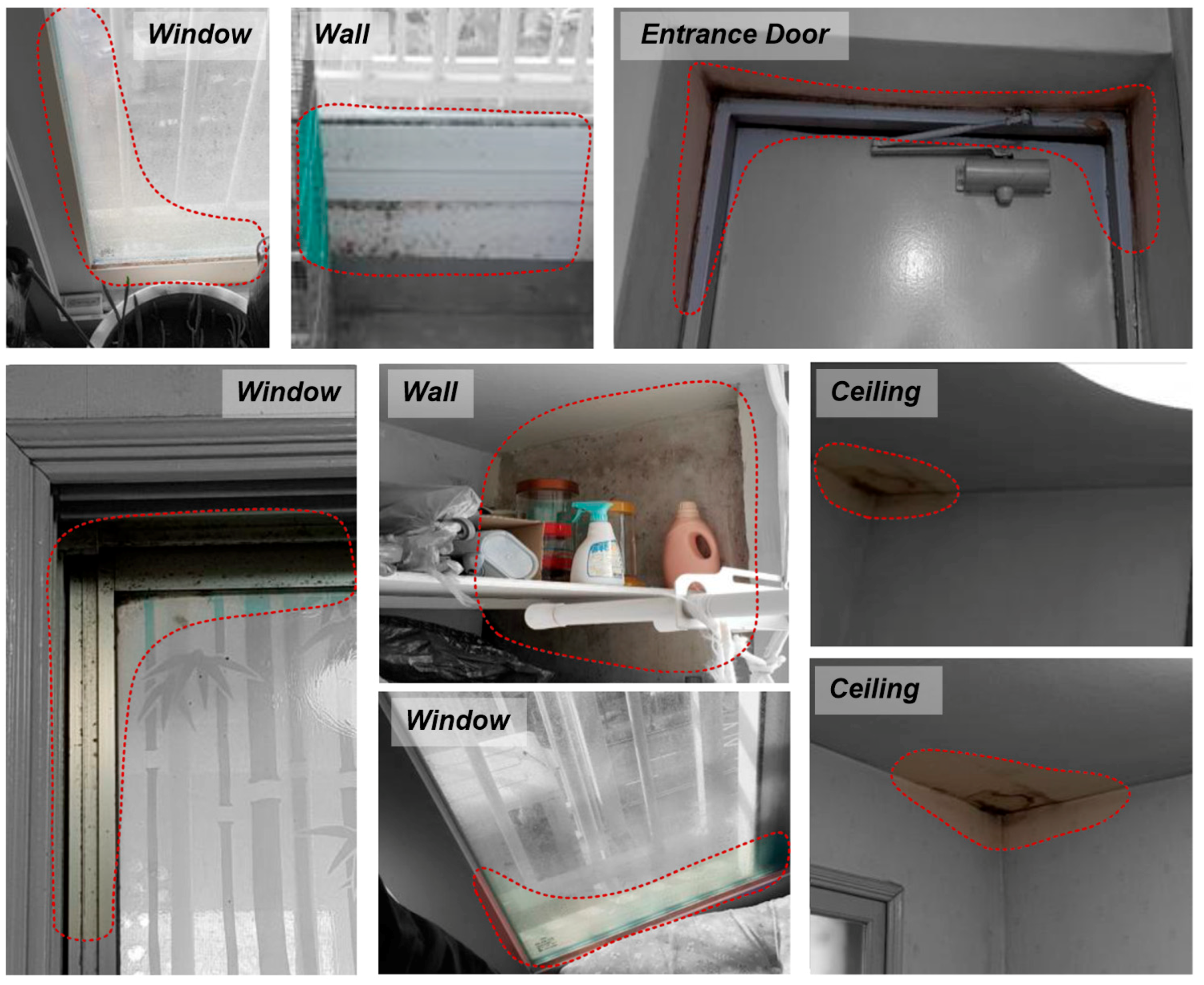
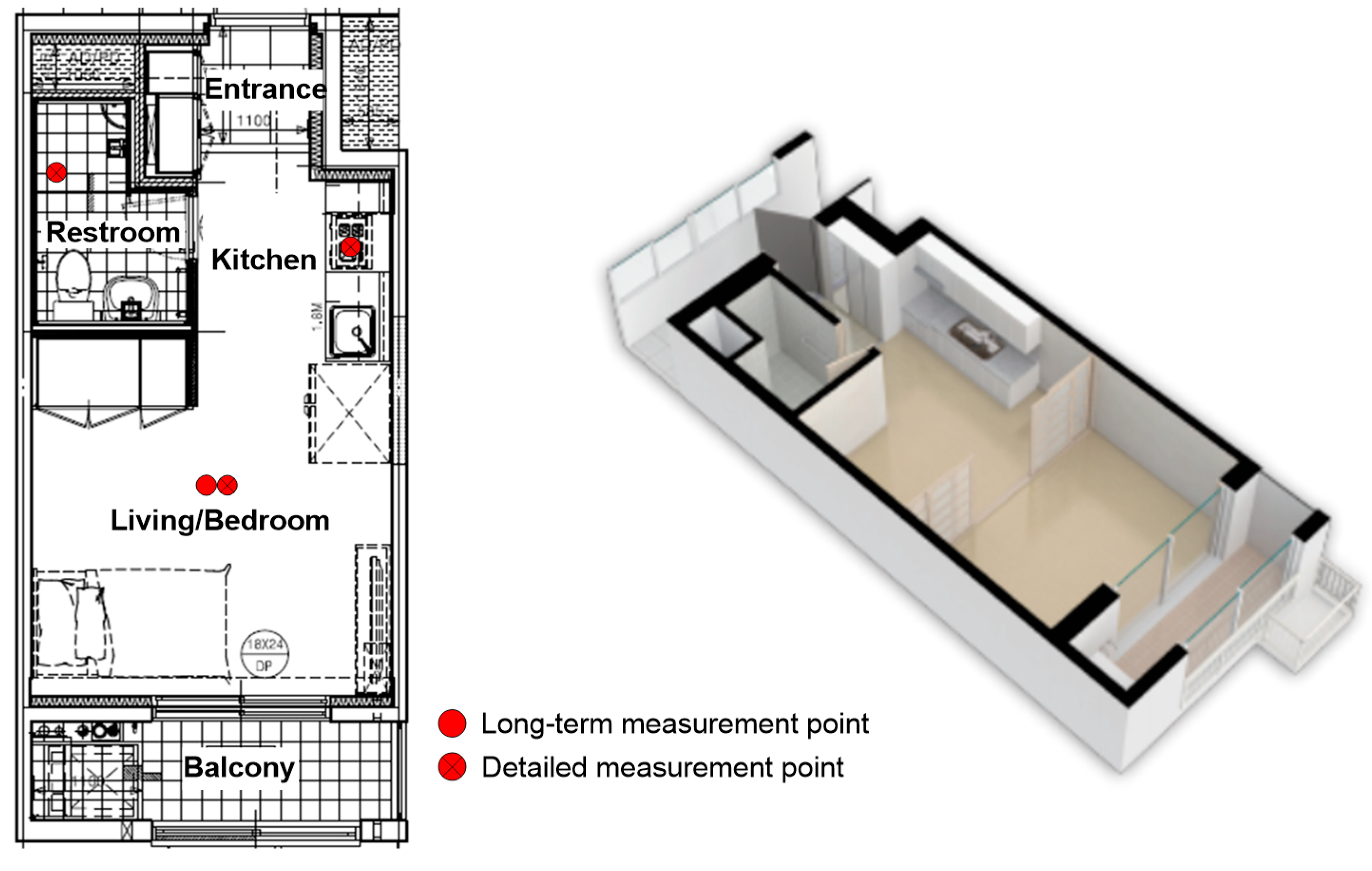
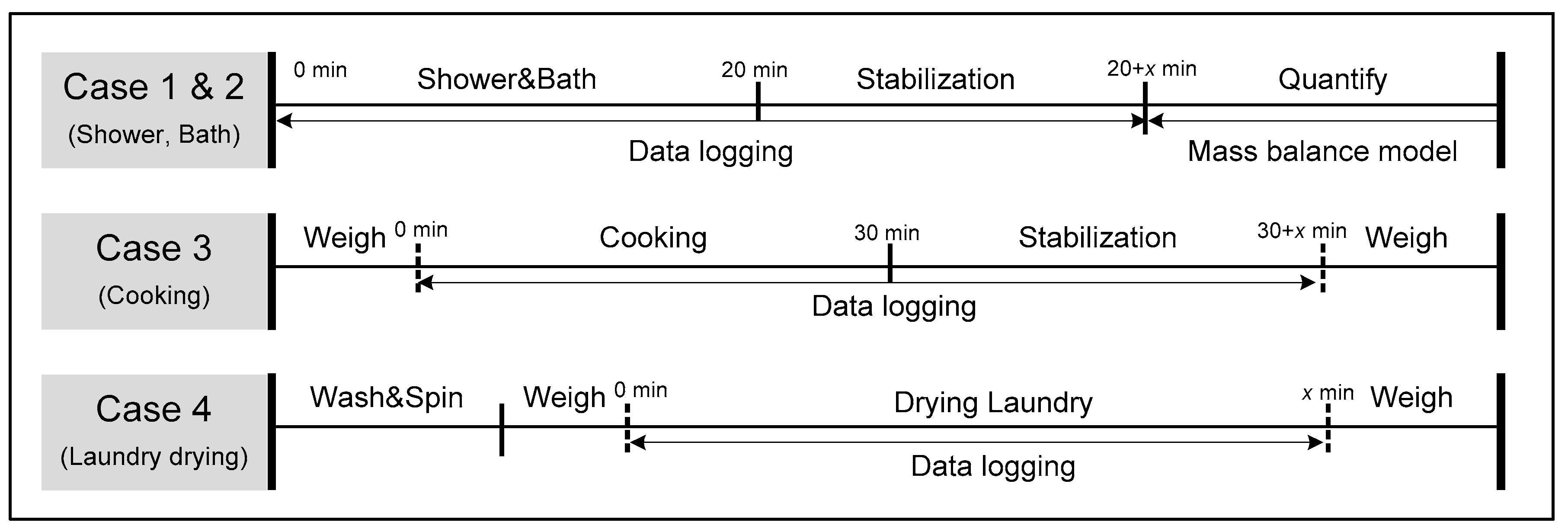
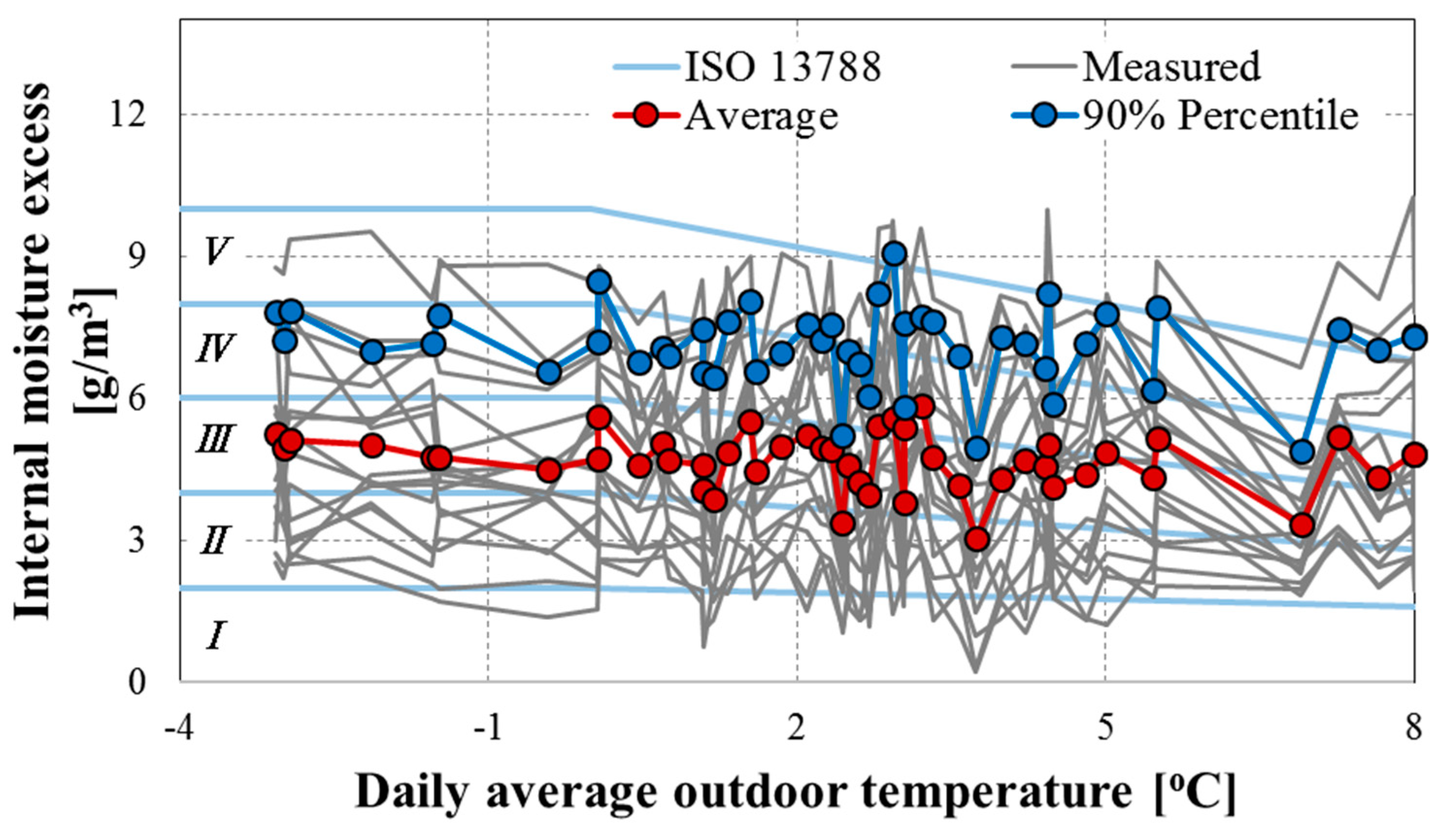
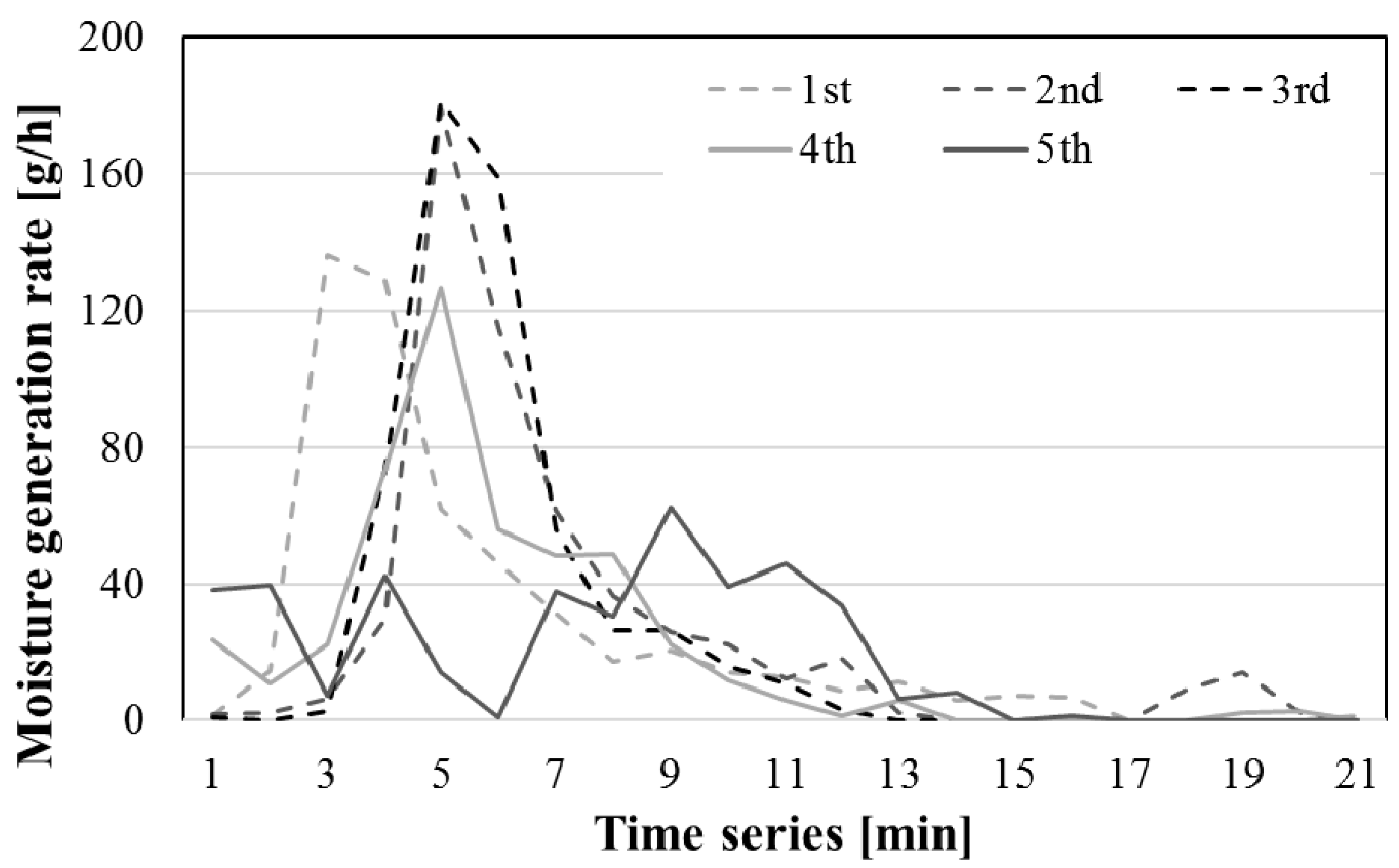
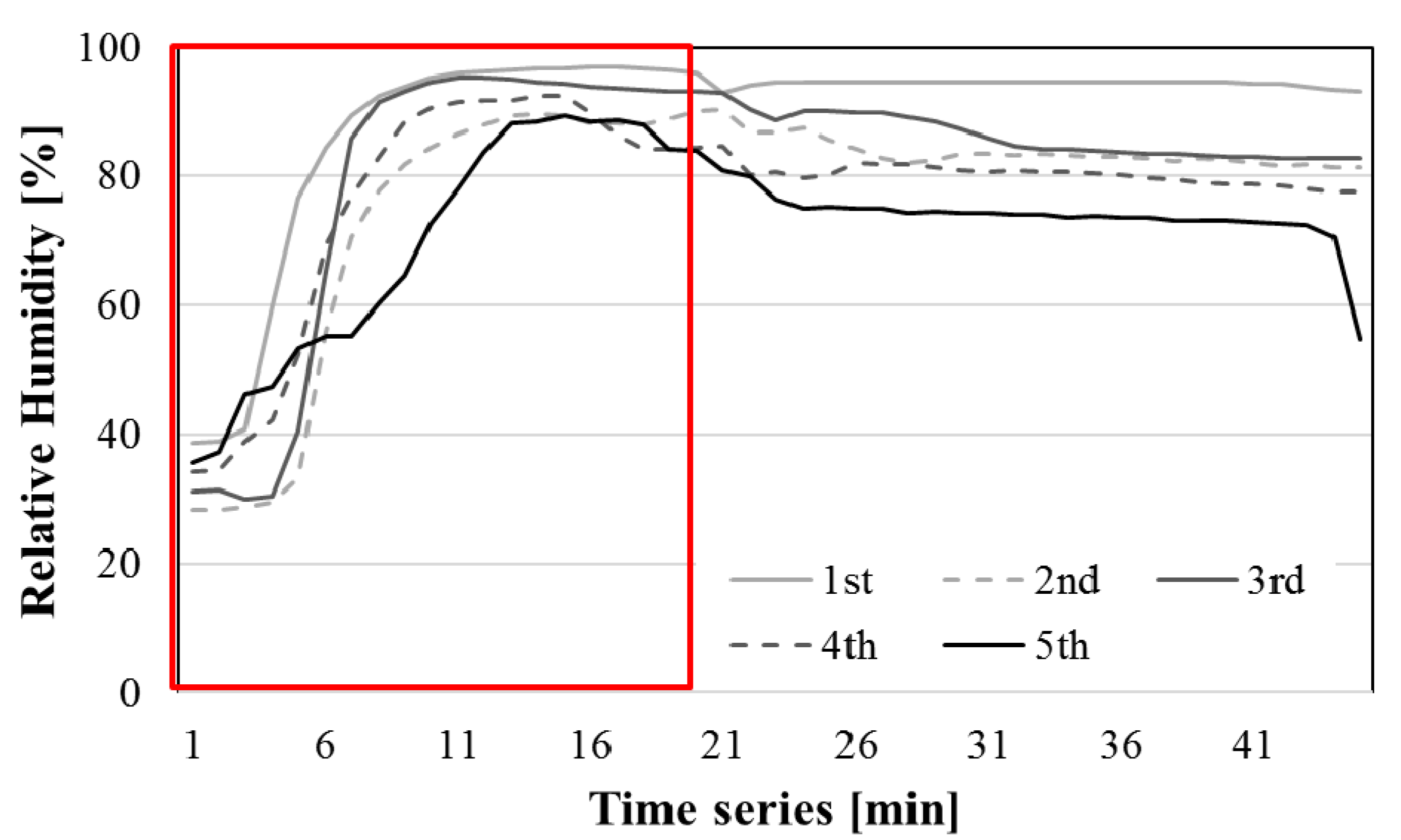
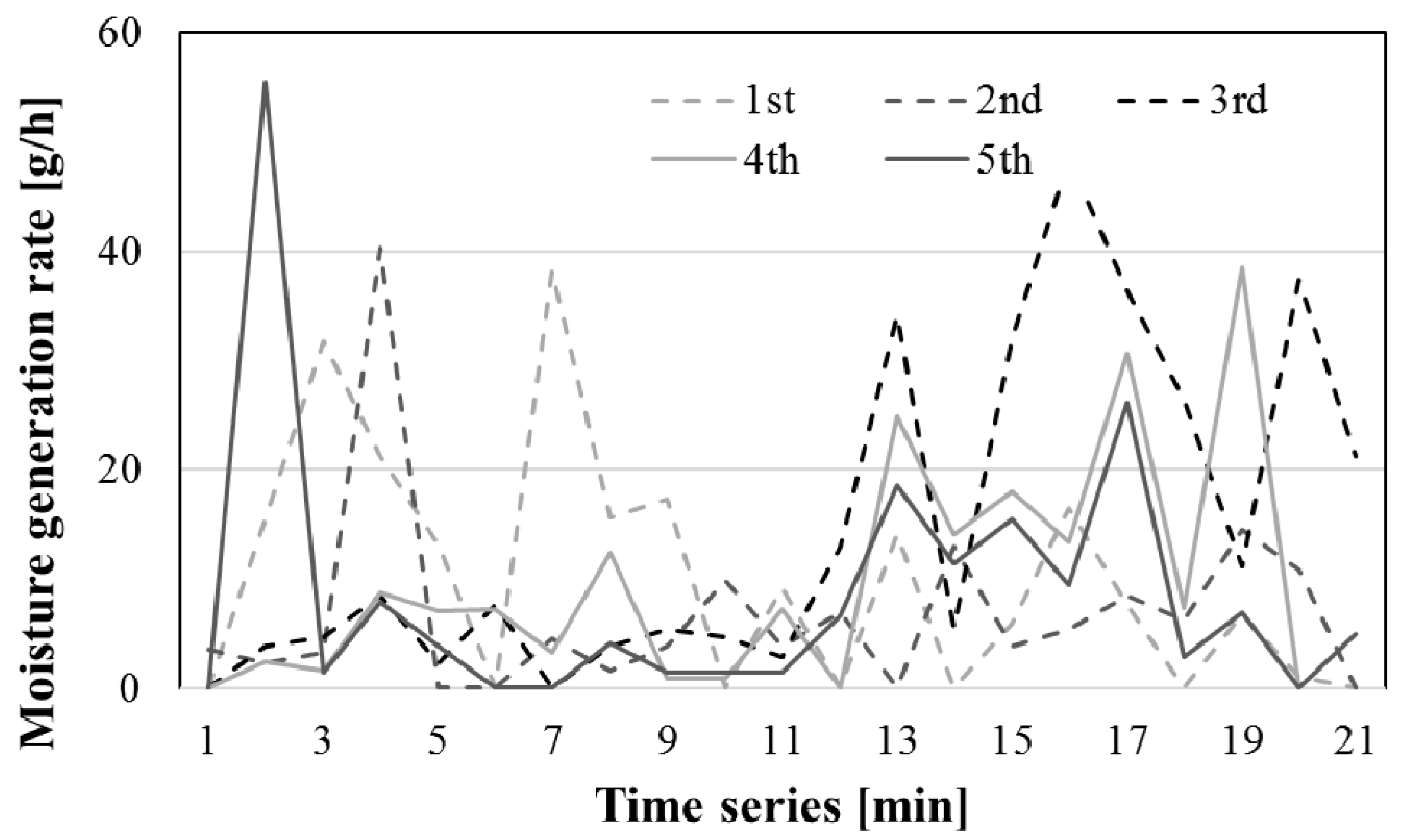
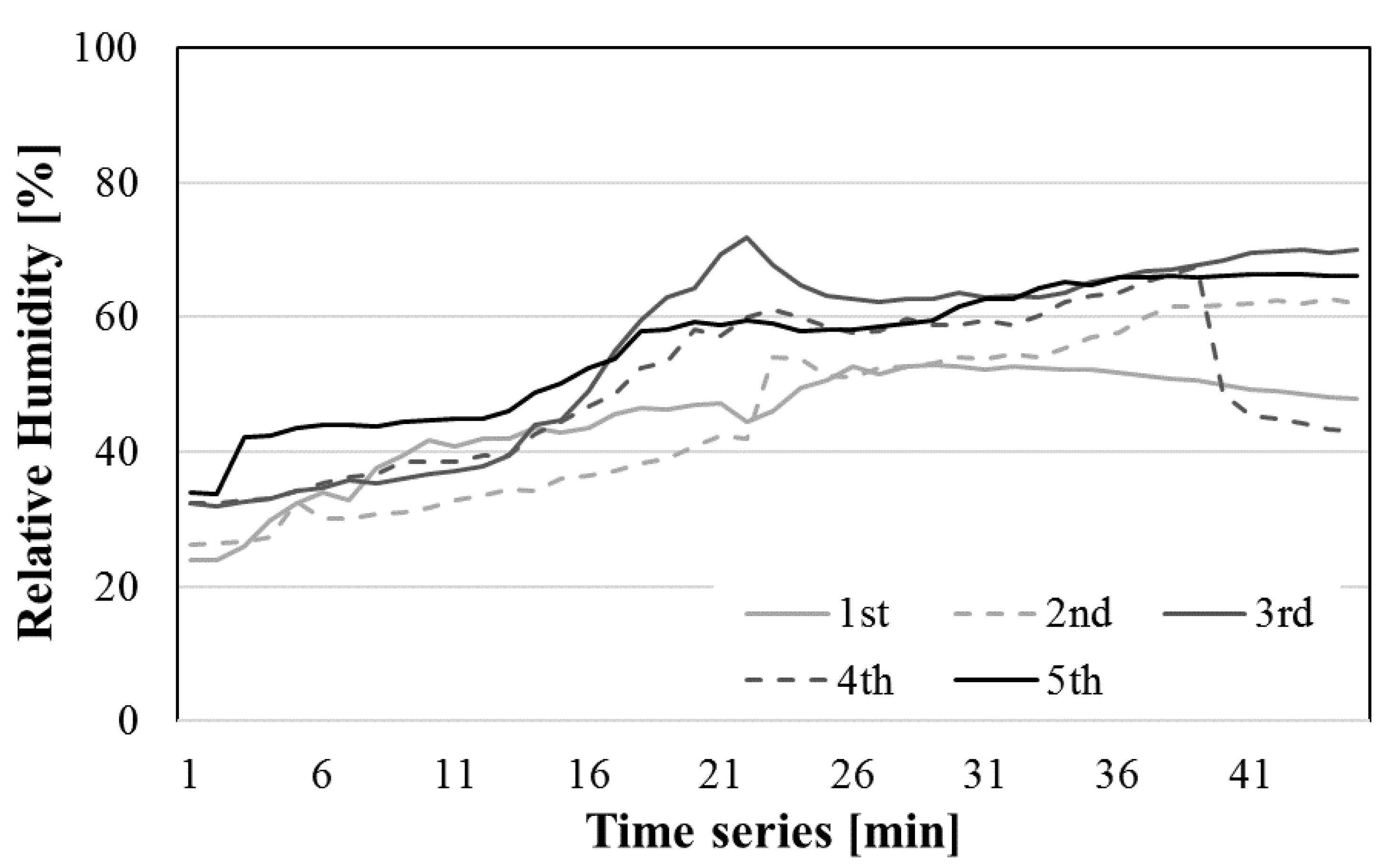
| Reference | Region | Dwelling Type | Room Type | n | Average Moisture Excess [G/M3] | |
|---|---|---|---|---|---|---|
| Warm | Cold | |||||
| Tout 5 °C, 15 °C | Tout 15 °C | |||||
| Janssens and Vandepitte (2006) [43], Vandepitte (2006) [44] | Belgium | Private single family | Living room | 17 | 0.5 * | 1.7 |
| Bedroom | 1.9 | |||||
| Social housing | Overall | 18 | 2.1 | |||
| Private housing | Overall | 4 | 1.5 | |||
| Kalamees et al. (2006) [45] | Finland | Lightweight timber-frame detached houses | Bedroom | 101 | 0.5 * | 1.9 |
| Living room | 0.4 * | 1.7 | ||||
| Stig Geving et al. (2011) [41] | Norway | Detached one-family house, semi-detached two- or four-family house, chained house, apartment building | Living room | 117 | 1.6 | 2.2 |
| Bedroom | 1.2 | 1.8 | ||||
| Bathroom | 2.8 | 3.6 | ||||
| Korpi et al. (2008) [46] | Finland | Heavyweight houses | Bedroom | 69 | 1.5 | 1.3 |
| Hagentoft et.al (2015) [47] | Denmark | Single-family house | Overall | 422 | 1.5 | - |
| Multi-family house | Overall | 58 | 1.8 | - | ||
| Kalamees et al. (2005) [42] | Estonia | Single-family lightweight detached house | Bedroom | 27 | 0.3 * | 1.6 |
| Living room | 0.2 * | 1.4 | ||||
| Internal Moisture Excess [G/M3] | |||||
|---|---|---|---|---|---|
| Average | SD | 10% | 90% | Remarks | |
| Overall | 4.69 | 1.97 | 2.20 | 7.42 | Tout 5 °C |
| Number of residents | |||||
| =1 | 4.53 | 1.66 | 2.06 | 6.11 | |
| >1 | 4.83 | 1.80 | 2.94 | 7.01 | |
| Construction age | |||||
| 3 year | 6.10 | 1.14 | 4.11 | 8.19 | |
| 27 year | 3.71 | 1.38 | 1.90 | 5.92 | |
| 1st | 2nd | 3rd | 4th | 5th | Avg. | |
|---|---|---|---|---|---|---|
| g/event (20 min) | 132.0 | 135.7 | 140.0 | 116.1 | 102.5 | 125.3 |
| g/h | 378.1 | 387.8 | 399.9 | 331.6 | 293.0 | 358.1 |
| 1st | 2nd | 3rd | 4th | 5th | Avg. | |
|---|---|---|---|---|---|---|
| g/event (20 min) | 51.3 | 34.1 | 74.2 | 52.6 | 43.1 | 51.1 |
| g/h | 153.8 | 102.4 | 222.5 | 157.7 | 129.4 | 153.2 |
| Before | After | g/Event | g/h | |
|---|---|---|---|---|
| 1st | 1152 | 885.9 | 275.6 | 532.2 |
| 2nd | 1205 | 903.3 | 305.4 | 603.4 |
| Avg. | - | - | 290.5 | 567.8 |
| Before | After | g/Event | g/h | |
|---|---|---|---|---|
| 1st | 5620 | 3996.5 | 1623.5 | 162.4 |
| 2nd | 5604 | 3940.4 | 1663.6 | 184.8 |
| Avg. | - | - | 1643.6 | 173.6 |
© 2020 by the authors. Licensee MDPI, Basel, Switzerland. This article is an open access article distributed under the terms and conditions of the Creative Commons Attribution (CC BY) license (http://creativecommons.org/licenses/by/4.0/).
Share and Cite
Choi, Y.; Lim, Y.; Kim, J.; Song, D. Why Does a High Humidity Level Form in Low-Income Households Despite Low Water Vapor Generation? Sustainability 2020, 12, 7563. https://doi.org/10.3390/su12187563
Choi Y, Lim Y, Kim J, Song D. Why Does a High Humidity Level Form in Low-Income Households Despite Low Water Vapor Generation? Sustainability. 2020; 12(18):7563. https://doi.org/10.3390/su12187563
Chicago/Turabian StyleChoi, Younhee, Younghoon Lim, Joowook Kim, and Doosam Song. 2020. "Why Does a High Humidity Level Form in Low-Income Households Despite Low Water Vapor Generation?" Sustainability 12, no. 18: 7563. https://doi.org/10.3390/su12187563
APA StyleChoi, Y., Lim, Y., Kim, J., & Song, D. (2020). Why Does a High Humidity Level Form in Low-Income Households Despite Low Water Vapor Generation? Sustainability, 12(18), 7563. https://doi.org/10.3390/su12187563






